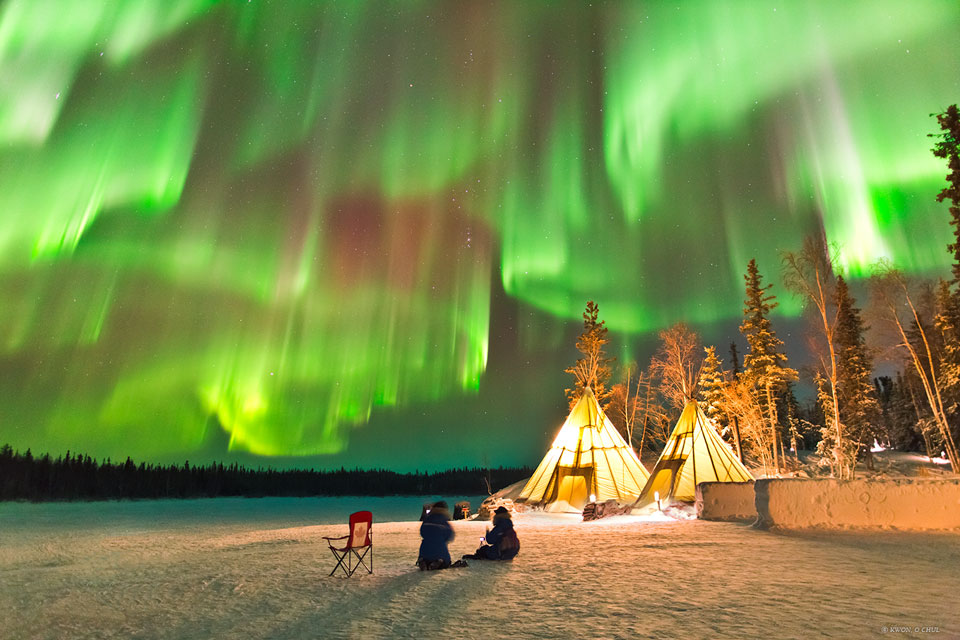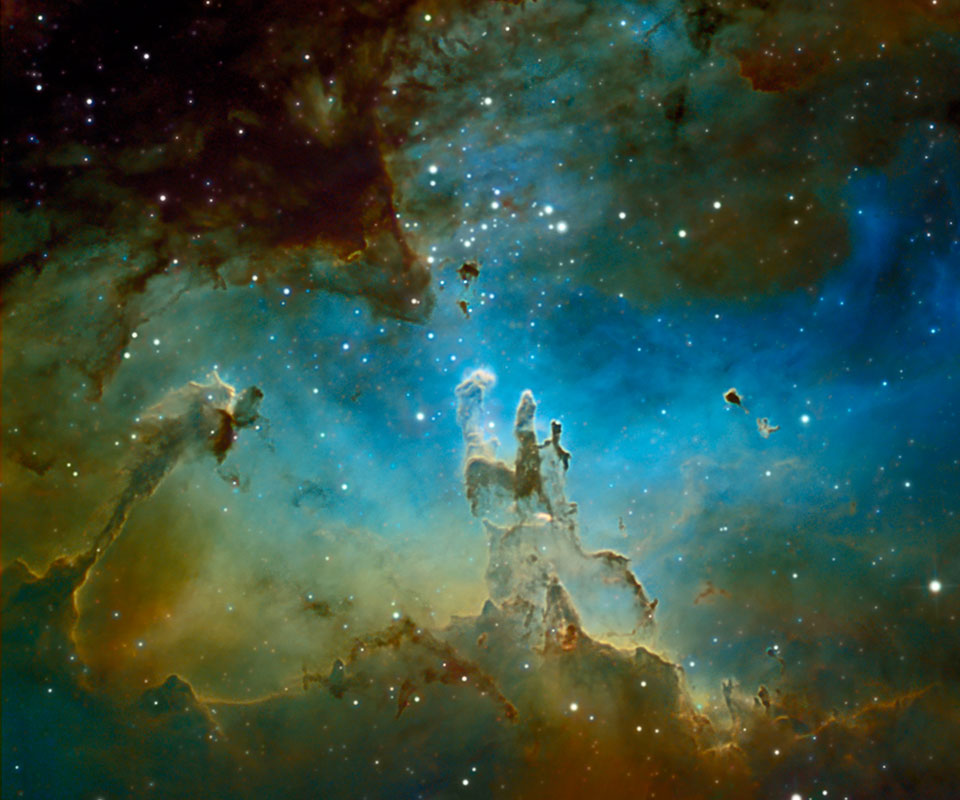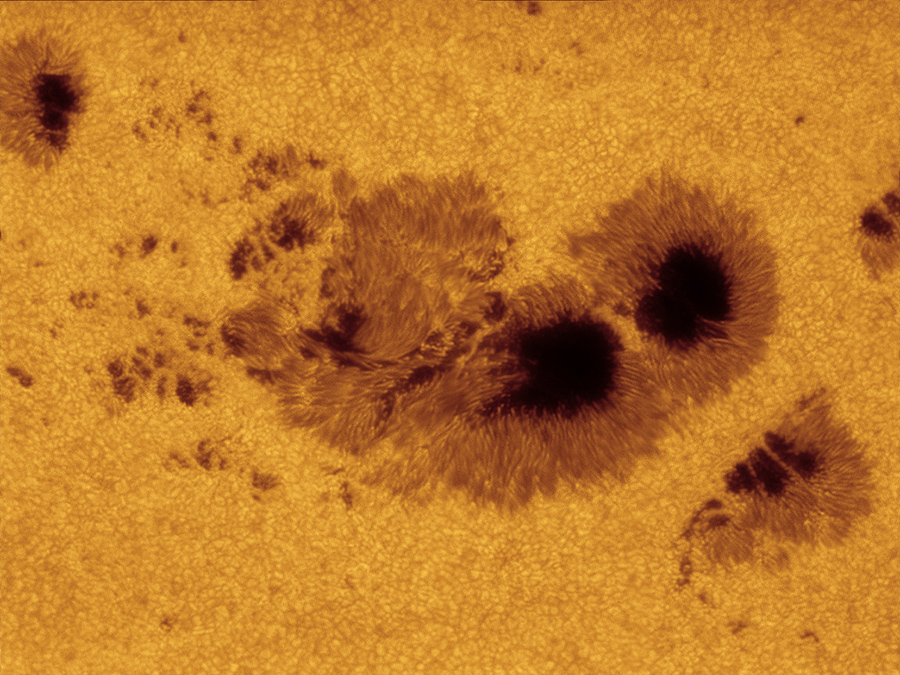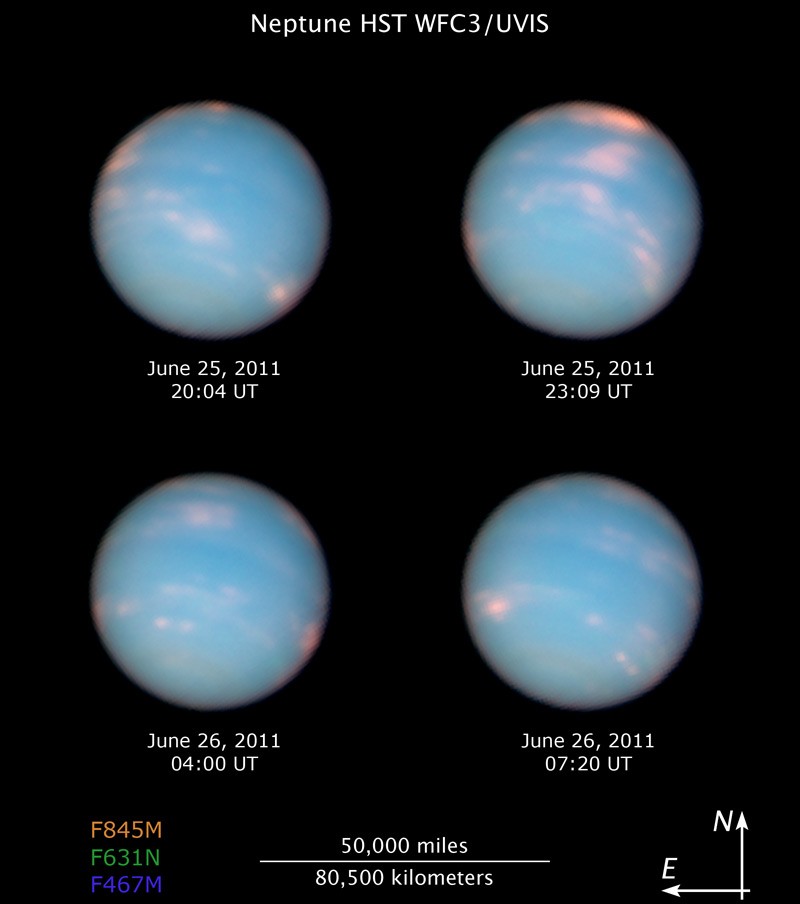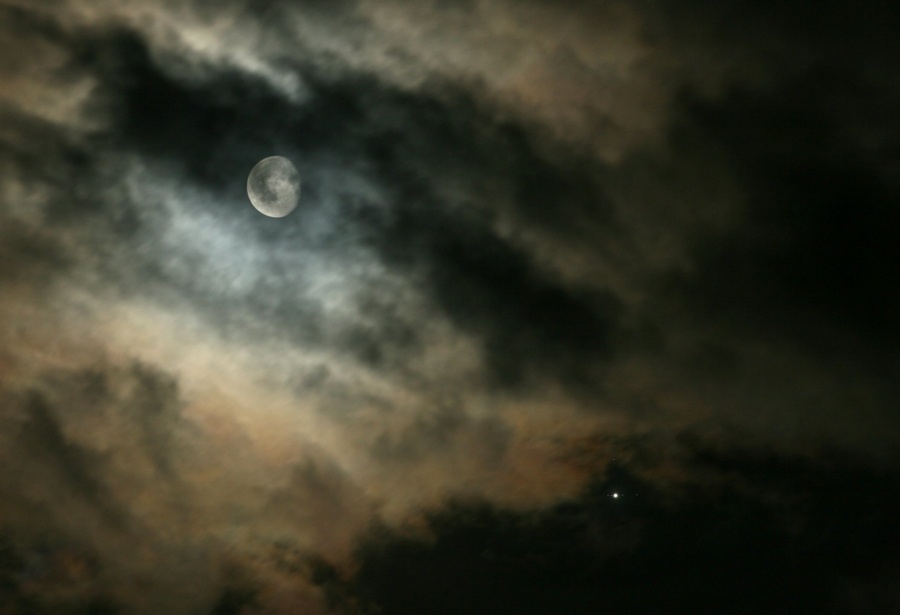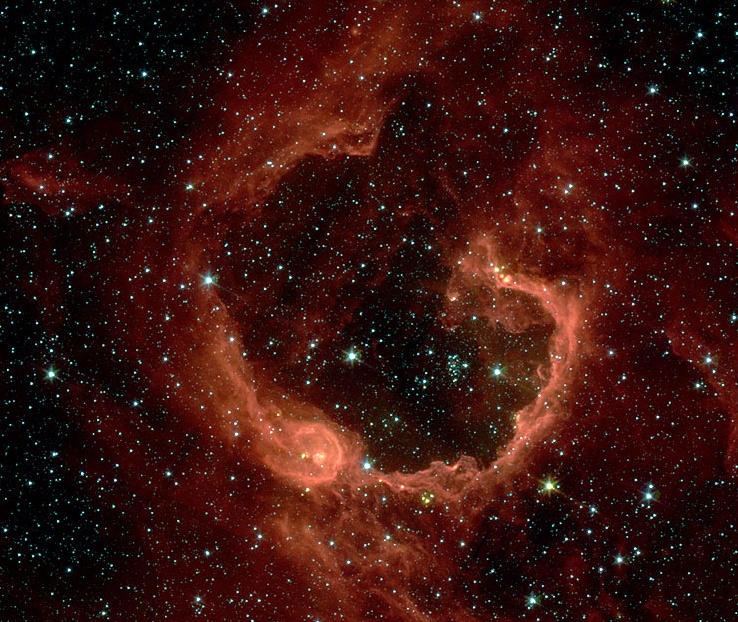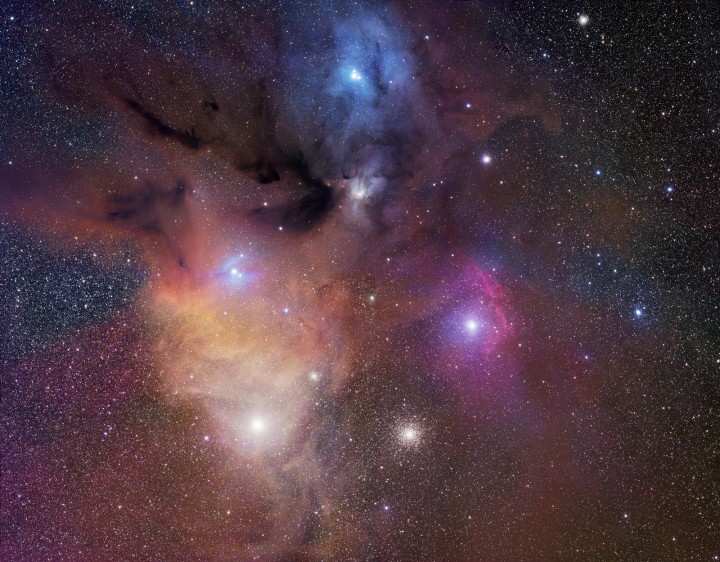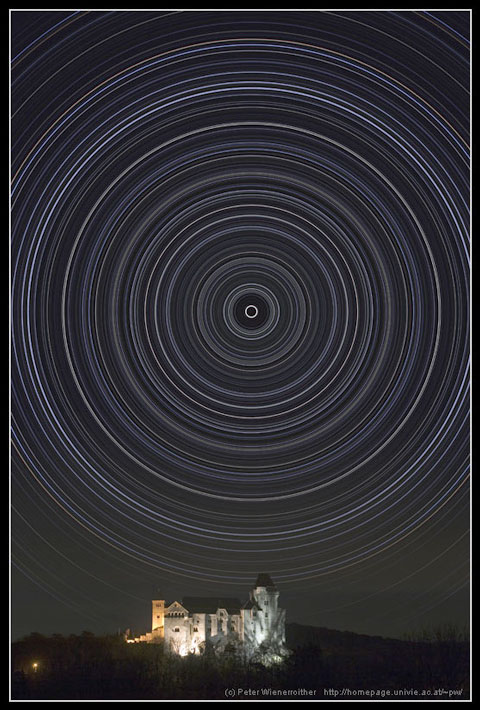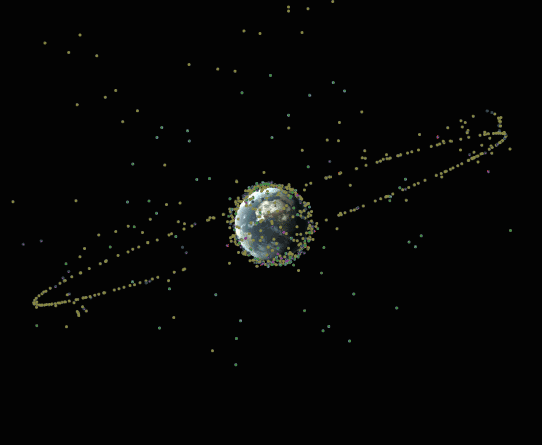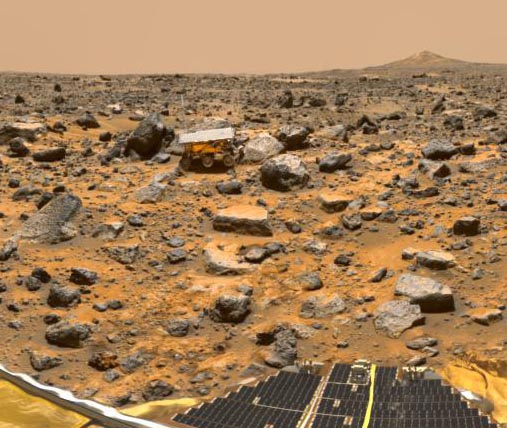| << Previous | Index | Next >> |
2015 Will the New Horizons spacecraft survive its closest approach to Pluto and return useful images and data? Humanity will know in a few hours. Regardless of how well it functions, New Horizon's rapid speed will take it whizzing past Pluto and its moons today, with the time of closest approach being at 11:50 UT (7:50 am EDT). To better take images and data, though, the robotic spacecraft was preprogrammed and taken intentionally out of contact with the Earth until about 1:00 am UT July 15, which corresponds to about 9:00 pm EDT on July 14. Therefore, much of mankind will be holding its breath through this day, hoping that the piano-sized spacecraft communicates again with ground stations on Earth. Hopefully, at that time, New Horizons will begin beaming back new and enlightening data about a world that has remained remote and mysterious since its discovery 85 years ago. Featured above is a New Horizons composite image of the moon Charon (left) and Pluto (right) taken 3 days ago, already showing both worlds in unprecedented detail.
2014 Gusting solar winds and blasts of charged particles from the Sun resulted in several rewarding nights last December for those anticipating auroras. The above image captured dramatic auroras stretching across a sky near the town of Yellowknife in northern Canada. The auroras were so bright that they not only inspired awe, but were easily visible on an image exposure of only 1.3 seconds. A video taken concurrently shows the dancing sky lights evolving in real time as tourists, many there just to see auroras, respond with cheers. The conical dwellings on the image right are teepees, while far in the background, near the image center, is the constellation of Orion.
2013 What lights up this castle of star formation? The familiar Eagle Nebula glows bright in many colors at once. The above image is a composite of three of these glowing gas colors. Pillars of dark dust nicely outline some of the denser towers of star formation. Energetic light from young massive stars causes the gas to glow and effectively boils away part of the dust and gas from its birth pillar. Many of these stars will explode after several million years, returning most of their elements back to the nebula which formed them. This process is forming an open cluster of stars known as M16.
2012 Awash in a sea of plasma and anchored in magnetic fields, sunspots are planet-sized, dark islands in the solar photosphere, the bright surface of the Sun. Dark because they are slightly cooler than the surrounding surface, this group of sunspots is captured in a close-up telescopic snapshot from July 11. The field of view spans nearly 100,000 miles. They lie in the center of active region AR1520, now crossing the Sun's visible face. In fact, an X-class solar flare and coronal mass ejection erupted from AR1520 on July 12, releasing some of the energy stored in the region's twisted magnetic fields. Headed this way, the coronal mass ejection is expected to arrive today and may trigger geomagnetic storms. As a result, some weekend auroral displays could grace planet Earth's skies along with Sunday's predawn conjunction of bright planets and crescent Moon.
2011 Neptune rotates once on its axis in about 16 hours. So, spaced about 4 hours apart these 4 images of the solar system's most distant gas giant cover one Neptune day. Recorded by the Hubble Space Telescope in late June they combine exposures made with visible and near-infrared filters to show high-altitude clouds composed of methane ice crystals against the planet's normally blue cloud tops. Because Neptune's axis of rotation is tilted to its orbital plane by 29 degrees, compared to Earth's 23.5 degrees, Neptune experiences seasons analogous to Earth's. As early summer comes to Neptune's southern hemisphere and winter to the north, Hubble observations have shown cloud activity shifting to the northern hemisphere. In fact the progression of Neptune's seasons has come around once since its position was predicted by French mathematician Urbain Le Verrier and British mathematician John Couch Adams, and the planet was subsequently discovered by German astronomer Johann Galle on September 23, 1846. With an orbital period of approximately 165 years, this week on July 12, Neptune has been once around the Sun since its discovery date.
2010 Makemake, a god in Easter Island mythology, may have smiled for a moment as clouds parted long enough to reveal this glimpse of July 11's total solar eclipse to skygazers. In the foreground of the dramatic scene, the island's famous large, monolithic statues (Moai) share a beachside view of the shimmering solar corona and the darkened daytime sky. Other opportunities to see the total phase of this eclipse of the Sun were also hard to come by. Defined by the dark part of the Moon's shadow, the path of totality tracked eastward across the southern Pacific Ocean, only making significant landfall at Mangaia (Cook Islands) and Easter Island (Isla de Pascua), ending shortly after reaching southern Chile and Argentina. But a partial eclipse phase could be enjoyed over a broader region, including many southern Pacific islands and wide swath of South America.
2009 Earth's Moon and planet Jupiter made a beautiful pairing in the night sky late last week. This skyscape recorded on July 11 from Brittany in north western France captures the bright conjunction through a cloud bank. The clouds add drama and mystery to the scene but they were also positioned to reduce the intense moonlight. As a result, the exposure captures Jupiter's own Galilean moons (lower right) as tiny pinpricks of light, lined up and hugging both sides of the solar system's ruling gas giant. Later this week, the Moon is headed for a conjunction with Mars and Venus in the dawn sky.
2008 Does Mars always appear the same? No. As both Earth and Mars orbit the Sun, the apparent angular size of Mars changes as viewed from the Earth. Pictured above from Enschede, Holland, Mars was captured in 2007 and 2008 with 30 separate images, all taken with the same magnification. When Earth and Mars are on opposite sides of the Sun, Mars appears relatively small. Conversely, when Earth and Mars are near each other, Mars looms large and bright. The largest Mars has appeared in recent history was the opposition of August 2003. Since Mars is always more distant from the Sun than the Earth, Mars never shows a crescent phase to Earthlings. Visible also in the above images are the north polar cap of Mars, dark and light soil, clouds, and, in the early images, a global dust storm. The next opposition, when Earth again passes near to Mars, will occur in early 2010.
2007 A cosmic bubble of gas and dust, RCW 79 has grown to about 70 light-years in diameter, blown by the winds and radiation from hot young stars. Infrared light from the dust embedded in the nebula is tinted red in this gorgeous false-color view from the Spitzer Space Telescope. A good 17 thousand light-years away in the grand southern constellation Centaurus, the expanding nebula itself has triggered star formation as it plows into the gas and dust surrounding it. In fact, this penetrating infrared picture reveals groups of new stars as yellowish points scattered along the bubble's edge. One remarkable group still lies within its own natal bubble at about 7 o'clock (lower left), while another can be seen near the upper gap at about 3 o'clock (right) from the bubble's center.
2006 This stunning mosiac of the sky around bright stars Antares (Alpha Scorpii) and Rho Ophiuchi reveals spectacular colors in a cosmic starscape. Near the top, Rho Ophiuchi and nearby stars are immersed in blue reflection nebulae - dust clouds that shine primarily by reflected starlight. Cool supergiant star Antares (lower left) is itself shedding the material that reflects the evolved star's yellowish hue. Characteristic of star forming regions, the telltale red emission from hydrogen gas also permeates the view along with dark, obscuring dust clouds seen in silhouette against the background stars and brighter nebulosities. About 500 light-years away, the Rho Ophiuchi star clouds, are well in front of the nearby globular star cluster M4, visible just below and right of center. The wide view spans about 6 degrees on the sky.
2005 As the Earth spins on its axis, the sky seems to rotate around us. This motion, called diurnal motion, produces the beautiful concentric trails traced by stars during time exposures. In the middle of the picture is the North Celestial Pole (NCP), easily identified as the point in the sky at the center of all the star trail arcs. The star Polaris, commonly known as the North Star, made the very short bright circle near the NCP. Full circle star trails are pictured over Vienna, Austria. This image, a relatively short exposure followed by a digital trick, could not have been taken during a single night because 24-hours are needed for one full rotation, and the Sun is sure to dominate the frame at some time.
2004 What's the best way to the city center? What looks like a street map of some city on Earth is actually a series of naturally-formed fragmented polar polygons on Mars. The existence of polar polygons on Mars is particularly interesting as they may indicate regions where water ice lies within a few meters of the surface. Similar looking polygons are commonly found in the arctic and Antarctic of Earth, where they typically form from a repetitive cycle of freezing and thawing. The above image spans a distance of about 3 kilometers and was taken recently by the orbiting Mars Global Surveyor.
2003 Thousands of satellites orbit the Earth. Costing billions of dollars, this swarm of high altitude robots is now vital to communication, orientation, and imaging both Earth and space. One common type of orbit is geostationary where a satellite will appear to hover above one point on Earth's equator. Geostationary orbits are very high up -- over five times the radius of the Earth -- and possible only because the satellite orbital period is exactly one day. It is usually cheaper to place a satellite in low Earth orbit, around 500 kilometers, just high enough to avoid the effect of Earth's atmosphere. The above animated sequence starts by showing the halo of Earth's satellites, including the ring at geostationary, and finishes by zooming in on the only one currently hosting humans: the International Space Station.
2002 The Crab Nebula, filled with mysterious filaments, is the result of a star that was seen to explode in 1054 AD. This spectacular supernova explosion was recorded by Chinese and (quite probably) Anasazi Indian astronomers. The filaments are mysterious because they appear to have less mass than expelled in the original supernova and higher speed than expected from a free explosion. In the above picture taken recently from a Very Large Telescope, the color indicates what is happening to the electrons in different parts of the Crab Nebula. Red indicates the electrons are recombining with protons to form neutral hydrogen, while blue indicates the electrons are whirling around the magnetic field of the inner nebula. In the nebula's very center lies a pulsar: a neutron star rotating, in this case, 30 times a second.
2001 Ranging throughout the solar system, these pictures all have something in common. They were taken with an 8 inch diameter telescope, a size popular with amateur astronomy buffs, and slightly modified "web cam" of the type widely used to send images out over the internet. The results are clearly remarkable for such inexpensive and readily available equipment. Each sharp image was produced from 20 to 30 frames which were digitally stacked and processed using free software. Until recently, digital imaging for amateur astronomers required a specialized camera, but the advent of low-light video surveillance cameras and web cams now presents other options for relatively bright solar system objects. Want to try some unconventional web cam astronomy? Geoff Chester, Public Affairs Officer at the U.S. Naval Observatory, offers these images and an account of his own adventures from a suburban front lawn near Washington D.C.
2000 Impact craters are common on Earth's moon but on Jupiter's large ice moon Europa, they are very rare. Over time, both bodies have been subjected to an intense pounding by the solar system's formative debris, but geological activity on Europa's surface seems to have erased most of these impact scars. This false-color infrared image from the Galileo spacecraft's NIMS instrument shows a newly discovered crater on Europa as a light red ring feature near center surrounding a dark core. For scale, the dark core is about 29 kilometers in diameter. Only seven comparably large craters have now been identified on Europa's surface. Red colors in the image represent a relatively pure water ice composition while blue colors indicate that other minerals are present. The crater's central dark area may contain the remnants of the impacting body. The icy crust of Europa is of great interest, as evidence mounts that it covers an ocean of liquid water, possibly providing suitable conditions for life.
1999 Are you an early riser? Over the last month or so, the bright planets Jupiter and Saturn have come to adorn eastern skies before sunrise. In fact, astrophotographer Joe Orman anticipated that an early bird's reward for looking east on June 10 would be this pleasing arrangement of Jupiter (top right), a crescent Moon, and Saturn (near center), but he was surprised to also find these eerie, iridescent clouds wafting through the pre-dawn sky over suburban Phoenix, Arizona, USA. The clouds turned out to be rocket engine trails from defense missile tests at the range in White Sands, New Mexico ... about 300 miles away. While the Moon's phase is just past new moon, gone now from the pre-dawn horizon, brilliant Jupiter and Saturn can still be seen high toward the southeast in the constellation Aries.
1998 To learn about the history ofMars, just ask the rocks. Last year, that's exactly what the robot rover Sojourner did. Sojouner can be seen, above, analyzing a rock nicknamed Moe, trying to discern its past. One significant discovery of the Mars Pathfinder mission was that of conglomerate rocks, indicating the presence of running water in the past. Such water, in turn, indicates that Mars was much more like watery Earth in the distant past. Visible in the foreground of this color-enhanced mosaic is part of the Sagan Memorial Station, while a hill nicknamed one of the "Twin Peaks" is visible about a kilometer in the distance.
1997 Get out your red/blue glasses and gaze across the surface of Mars in stereo. You are looking south of west across an ancient flood channel, Ares Vallis, landing site of the Mars Pathfinder. A rover deployment ramp and lander petal define the foreground in this 3D-view while a field of rocks seems to stretch to the horizon. At the upper right, over half a mile distant, are the hills known as the "Twin Peaks". Today is Sol 10, the tenth day the Pathfinder lander and Sojourner rover have been operating on the martian surface. Over that period, the mission has been returning a wealth of images and data. The otherwise successful rover activities have been recently hampered by some communication and computer difficulties.
1996 Here's what a spiral galaxy REALLY looks like. Yesterday, M81 was shown in two colors only, but here we see M81 at its most colorful. In the above picture, note how blue the spiral arms are - this indicates the presence of hot young stars and on-going star formation. Also note the yellow hue of the nucleus, possibly designating a population of older stars many billions of years old. M81 is actually a dominant member of a group of galaxies which includes M82 and several other galaxies. Unlike our Local Group of galaxies, large galaxies in the M81 group are actually colliding. It is possible that M81's interaction with M82 create the density waves which generate M81's spiral structure.
1995 In July of 1994, pieces of Comet Shoemaker-Levy 9, also known as the "string of pearls" comet, collided with the planet Jupiter. As the comet fragments smashed in to Jupiter, the resulting explosions scattered large quantities of dusty cometary debris into the Jovian atmosphere. The clouds of debris created the multiple dark smudges visible in this picture. Jupiter's rotation causes the successive impact sites to be strung out along the cloud bands while the strong winds cause the appearance of the smudges to change with time. Jupiter's famous red spot is also visible to the left of center.
| << Previous | Index | Next >> |

